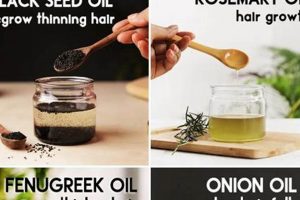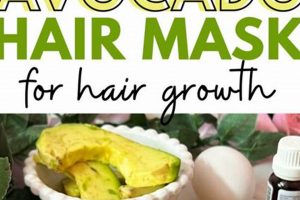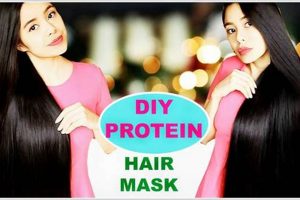The topical application of a self-prepared treatment for hair, utilizing the fruit Persea americana as a primary ingredient, represents a cost-effective and natural approach to hair care. For instance, individuals may combine mashed avocado with oils such as olive or coconut oil to create a moisturizing compound.
The practice offers potential benefits including increased hair hydration, enhanced shine, and reduced breakage due to the fruit’s high fat and nutrient content. Historically, natural ingredients have been used for cosmetic purposes across various cultures, with avocados gaining prominence for their emollient properties in modern hair care routines.
Subsequent discussion will delve into the specific advantages of using this particular treatment, provide guidelines for preparation and application, and address potential considerations for different hair types. Furthermore, alternative ingredients and variations on the basic formulation will be explored.
Application Strategies for Homemade Hair Treatments
The following recommendations aim to optimize the effectiveness of self-prepared hair treatments utilizing Persea americana. Adherence to these guidelines may enhance results and minimize potential adverse effects.
Tip 1: Selection of Ripe Fruit: The avocado should yield to gentle pressure, indicating optimal ripeness. Overripe fruit may possess an undesirable odor and compromised texture, potentially affecting the treatment’s consistency and efficacy.
Tip 2: Thorough Mashing: Ensure the avocado is thoroughly mashed to eliminate lumps, facilitating even distribution throughout the hair and preventing residue buildup.
Tip 3: Incorporation of Carrier Oils: Complement the avocado with oils such as olive, coconut, or argan oil. These oils contribute to increased moisturization and ease of application.
Tip 4: Application to Damp Hair: Apply the treatment to damp, not dripping wet, hair. Damp hair absorbs the treatment more effectively. Section the hair for uniform coverage from root to tip.
Tip 5: Scalp Massage: Gently massage the treatment into the scalp to stimulate circulation and promote nutrient absorption. However, individuals with oily scalps should minimize scalp application.
Tip 6: Adequate Processing Time: Allow the treatment to remain on the hair for 20-30 minutes. Covering the hair with a shower cap can trap heat and enhance penetration of the treatment.
Tip 7: Thorough Rinsing: Rinse the hair thoroughly with lukewarm water to remove all traces of the treatment. Inadequate rinsing can lead to a greasy or weighed-down appearance.
Consistent application, typically once or twice per week, allows for sustained hydration and improvement in hair’s overall health and appearance. Observe hair’s reaction to the treatment and adjust frequency as needed.
The subsequent section will address potential variations in preparation techniques to cater to specific hair types and concerns.
1. Fruit Ripeness
The stage of maturity in Persea americana significantly impacts the efficacy of self-prepared hair treatments. Optimal fruit ripeness is critical for maximizing nutrient bioavailability and ensuring desired texture. The following factors elaborate on this relationship.
- Nutrient Concentration
As the fruit ripens, the concentration of beneficial fatty acids and vitamins increases. These nutrients, essential for hair hydration and strength, are most abundant when the fruit has reached its peak ripeness. Premature or overripe fruit may contain lower concentrations, potentially diminishing the treatment’s beneficial effects.
- Texture and Consistency
A perfectly ripe avocado possesses a smooth, creamy texture ideal for hair mask application. This consistency allows for even distribution throughout the hair strands. Underripe avocados are firm and difficult to mash, resulting in a lumpy mixture. Overripe avocados may become mushy and develop an undesirable odor, both negatively impacting the treatment’s application and aesthetic appeal.
- Enzyme Activity
Enzymatic processes occurring during ripening influence the fruit’s composition. While some enzymatic activity is beneficial, excessive enzyme activity in overripe fruit can degrade nutrients and alter the fruit’s chemical structure, potentially reducing the treatment’s effectiveness. Controlled ripening preserves the desired nutrient profile.
- pH Level
The pH level of the fruit undergoes changes during the ripening process. Maintaining an optimal pH is crucial for compatibility with hair’s natural pH. Imbalances in pH, often associated with overripe fruit, can disrupt the hair’s cuticle, potentially leading to damage or irritation. Monitoring the fruit’s ripeness ensures a more balanced pH level for the hair treatment.
The interconnectedness of these facets underscores the importance of selecting avocados at their peak ripeness for preparing homemade hair treatments. Adherence to this principle maximizes nutrient delivery, ensures optimal texture, controls enzymatic activity, and maintains pH balance, collectively contributing to a more effective and beneficial application.
2. Ingredient Proportions
The relative quantities of components within a self-prepared hair treatment significantly determine its efficacy and suitability for diverse hair types. Meticulous adjustment of ingredient proportions is crucial for achieving desired outcomes and minimizing potential adverse reactions.
- Avocado-to-Oil Ratio
The balance between mashed avocado and carrier oils (e.g., olive, coconut, argan) influences the treatment’s moisturizing potential and ease of application. Higher oil concentrations are generally beneficial for dry or coarse hair, promoting increased lubrication and manageability. Conversely, oily or fine hair may require a lower oil-to-avocado ratio to prevent excessive greasiness and product buildup.
- Humectant Incorporation
Humectants, such as honey or glycerin, attract moisture from the environment into the hair shaft. Their inclusion in the formulation can enhance hydration, particularly for dry or damaged hair. However, excessive humectant use in high-humidity environments can lead to frizziness. The proportion of humectants must therefore be adjusted based on climate and hair porosity.
- Acidic Modifiers
The addition of acidic ingredients, such as lemon juice or apple cider vinegar, can help to balance the pH of the hair and scalp. Acidic pH levels promote cuticle smoothing, resulting in increased shine and reduced frizz. However, excessive acidity can be damaging, especially for chemically treated or fragile hair. Acidic modifiers should be used sparingly, and the formulation’s pH should be carefully monitored.
- Protein Enrichment
For damaged or protein-deficient hair, the incorporation of protein-rich ingredients like egg yolk or yogurt can provide structural support and enhance elasticity. However, excessive protein can lead to stiffness and breakage, particularly in hair that is not protein-deficient. The proportion of protein-rich ingredients should be carefully calibrated to avoid protein overload.
These multifaceted considerations regarding ingredient proportions underscore the importance of tailoring each self-prepared hair treatment to the individual’s specific hair type and needs. Careful experimentation and observation are crucial for optimizing the formulation and achieving desired results with the fruit-based hair mask.
3. Application Technique
The methodology employed during the application of a self-prepared hair treatment based on Persea americana significantly influences its efficacy. Proper application ensures uniform distribution of the treatment, maximizes nutrient absorption, and minimizes potential waste or scalp irritation.
- Sectioning and Distribution
Dividing hair into manageable sections prior to application facilitates even distribution of the treatment. This practice ensures that all hair strands receive adequate coverage, promoting consistent hydration and nutrient delivery. Neglecting to section the hair can result in uneven application, leading to some areas receiving excess product while others remain untreated.
- Scalp Contact and Massage
The extent to which the treatment is applied to the scalp impacts scalp health and hair follicle stimulation. Gentle massage of the treatment into the scalp can promote blood circulation, potentially stimulating hair growth. However, individuals with oily scalps may wish to minimize scalp contact to prevent excessive sebum production. The appropriate level of scalp contact is contingent upon individual scalp conditions and hair type.
- Coverage and Saturation
Adequate saturation of hair strands with the treatment is essential for optimal results. The treatment should thoroughly coat each strand from root to tip, ensuring that the hair fully absorbs the moisturizing and nourishing compounds. Insufficient coverage can result in diminished effects, while excessive application may lead to product buildup and difficulty rinsing.
- Processing Time Management
The duration the treatment remains on the hair is critical for allowing sufficient time for nutrient absorption. Recommended processing times typically range from 20 to 30 minutes. Exceeding this timeframe may not significantly enhance the treatment’s effects and can potentially lead to scalp irritation. Conversely, insufficient processing time may limit the treatment’s efficacy.
These facets of application technique, when properly executed, contribute to the overall success of self-prepared Persea americana-based hair treatments. The appropriate method must be adapted to suit the individual’s hair type, scalp condition, and specific treatment goals to maximize the benefits and minimize any potential adverse effects.
4. Rinsing Thoroughness
The degree to which a hair treatment is removed following application directly impacts the outcome of a self-prepared regimen incorporating avocado. Inadequate rinsing can negate intended benefits, while meticulous rinsing optimizes the treatment’s positive effects.
- Residue Buildup
Insufficient rinsing leaves behind remnants of avocado and any accompanying ingredients. This residue accumulates over time, weighing down the hair, diminishing volume, and creating a dull appearance. For example, a buildup of oily residue from incomplete rinsing can attract dirt and pollutants, leading to an unhygienic scalp environment.
- Scalp Irritation
Residual avocado particles on the scalp can foster an environment conducive to microbial growth, potentially leading to irritation, itching, or even dermatitis. The natural sugars and oils present in avocado, when not fully removed, can act as a food source for microorganisms, exacerbating scalp conditions.
- Hair Texture Alteration
Incompletely rinsed avocado treatments can alter the hair’s natural texture. For fine hair, this often manifests as a greasy or stringy appearance. For coarser hair, residue may create a sticky or stiff feel. The altered texture can impact styling ease and overall manageability.
- Diminished Shine
While the initial application of an avocado treatment can impart shine, inadequate rinsing counteracts this effect. Residual oils and particulate matter scatter light, reducing the hair’s reflective properties and resulting in a lackluster appearance. Thorough rinsing removes the excess, allowing the hair’s natural shine to be revealed.
Consequently, rigorous rinsing protocols, employing lukewarm water and potentially a mild clarifying shampoo, are essential for maximizing the benefits of a do-it-yourself avocado hair mask while minimizing potential adverse effects. The investment in thorough rinsing directly translates to improved hair health and aesthetic appeal.
5. Hair Type Suitability
The efficacy of self-prepared hair treatments utilizing avocado is fundamentally contingent upon the hair’s inherent characteristics. Understanding hair type is paramount to maximizing benefits and mitigating potential adverse effects. A formulation appropriate for one hair type may prove detrimental to another.
- Fine Hair Considerations
Fine hair, characterized by a smaller diameter and lower density, is particularly susceptible to weighing down. A hair treatment rich in heavy oils, common in some avocado formulations, can render fine hair limp and lifeless. Modifications, such as reducing oil content or incorporating lightweight humectants, are necessary to maintain volume and manageability. For instance, substituting coconut oil with aloe vera gel can provide hydration without excessive weight.
- Coarse Hair Demands
Coarse hair, in contrast, possesses a larger diameter and often exhibits dryness. This hair type benefits from the emollient properties of avocado and heavier oils. The standard formulation may be insufficient to fully hydrate and soften coarse hair, necessitating the addition of ingredients such as shea butter or argan oil. This augmentation enhances the treatment’s ability to penetrate the hair shaft and improve texture.
- Oily Hair Precautions
Oily hair requires careful management of the avocado’s inherent oil content. Excessive application or formulations rich in additional oils exacerbate oiliness, leading to a greasy appearance. Incorporating clarifying agents, such as lemon juice, or reducing the proportion of oil is crucial. A diluted treatment applied sparingly focuses on the ends while avoiding the scalp minimizes potential issues.
- Chemically Treated Hair Sensitivities
Chemically treated hair, including that which is dyed, permed, or relaxed, exhibits increased porosity and fragility. Harsh ingredients, even those naturally derived, can further damage the hair’s structure. Gentle formulations with minimal acidity are essential. A test strand application is recommended to assess compatibility and prevent adverse reactions, such as color fading or increased breakage.
In summation, the utility of a self-prepared avocado hair treatment hinges on a nuanced understanding of individual hair characteristics. Tailoring the formulation and application technique to suit the specific needs of the hair ensures optimal results and prevents unintended damage. Failure to account for hair type can result in diminished efficacy or adverse cosmetic outcomes.
Frequently Asked Questions
This section addresses common inquiries regarding the preparation and application of homemade hair treatments utilizing Persea americana (avocado). The responses aim to provide clarity and guidance based on established principles of hair care.
Question 1: Is it necessary to use organic avocados for hair masks?
The use of organic avocados is not strictly necessary, but is recommended to minimize exposure to pesticides and other potentially harmful chemicals. Non-organic avocados should be thoroughly washed before use to remove surface residues.
Question 2: Can other ingredients be added to an avocado hair mask?
Yes, various ingredients may be added to enhance the treatment’s benefits. Common additions include carrier oils (e.g., olive, coconut, argan), honey, egg yolk, and essential oils. Ingredient selection should be tailored to individual hair needs and concerns.
Question 3: How frequently should an avocado hair mask be applied?
Application frequency depends on hair type and condition. Generally, a treatment once or twice per week is suitable for dry or damaged hair. Oily hair may benefit from less frequent applications (e.g., once every two weeks) or a modified formulation with reduced oil content.
Question 4: Can an avocado hair mask be used on color-treated hair?
Yes, avocado hair masks can generally be used on color-treated hair. However, it is advisable to perform a strand test prior to full application to assess potential color alteration. The addition of acidic ingredients (e.g., lemon juice) should be minimized to prevent color fading.
Question 5: How should an avocado hair mask be stored?
Prepared avocado hair masks are best used immediately. If storage is necessary, the mixture should be placed in an airtight container in the refrigerator and used within 24 hours to prevent oxidation and bacterial growth.
Question 6: Are there any contraindications to using avocado on hair?
While generally safe, individuals with avocado allergies should avoid topical application. In rare cases, individuals may experience scalp irritation. A patch test on a small area of skin is recommended prior to full application to identify potential allergic reactions.
These responses offer guidance on common concerns pertaining to the use of homemade avocado hair treatments. However, individual results may vary, and consulting with a qualified hair care professional is recommended for personalized advice.
The subsequent section will explore alternative natural ingredients that can be used in conjunction with or as replacements for avocado in homemade hair treatments.
Concluding Remarks on Self-Prepared Avocado Hair Treatments
This exploration of “hair mask diy avocado” has delineated the multifaceted considerations involved in utilizing Persea americana for hair care. Key points emphasized include the importance of fruit ripeness, precise ingredient proportions, meticulous application techniques, thorough rinsing protocols, and careful attention to hair type suitability. Deviation from these principles can compromise the treatment’s efficacy and potentially lead to adverse cosmetic outcomes.
The responsible and informed application of these guidelines holds the potential to unlock the benefits of this natural treatment. Individuals are encouraged to approach self-prepared hair care with diligence and observation, recognizing that optimal results derive from a nuanced understanding of individual hair characteristics and needs. Further research into alternative natural ingredients and advanced formulation techniques may yield additional insights and refinements in this domain.







